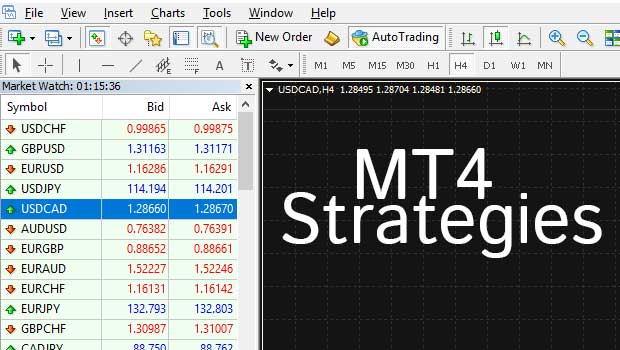ABCD Pattern Trading How to Trade the ABCD

ABCD trading pattern is a trend that stocks take in the market, observable on price charts. The sequence of events follows a particular harmonic pattern in market movement that can be helpful to traders in predicting future price swings. The best way to scan for abcd patterns is to look for intraday momentum. Often times, right after the market opens, you’ll find stocks that are trending upward or downward. One of the best ways to look for this is on the high/low scanner that your brokerage or charting platform provides.
By understanding the psychology behind the pattern, we can make sure that we are entering our trades at the right time and with the right market conditions. Study the chart looking at the highs and lows of the price. For a bullish ABCD pattern, C has to be lower than A and should be the intermediate high after the low at B. As with the bullish ABCD pattern, the bearish pattern begins with a sharp move to the upside. The pattern is essentially the opposite of the bullish pattern, rising where the bull pattern falls and falling where the bull pattern rises.
The hammer and shooting star patterns are commonly used by ABCD traders for extra confirmation, as are tweezer tops/bottoms and engulfing candles. You could choose to wait for one of these candlesticks to form before entering with a market order. If there is, then your analysis is more likely to be correct. Now that we understand how to identify the ABCD stock and Forex pattern, we can start applying it to real price action. If you want to follow along, you may consider using the FXOpen TickTrader platform. There you’ll be able to use the built-in ABCD drawing tool that automatically calculates the Fibonacci ratios between points.
And it is far and away the most consistent pattern because it’s rooted in market fundamentals. When time, price and shape all manifest in a stock chart in the form of an ABCD pattern, it’s a good indicator for making a smart trading decision. The up and down action of a stock may seem chaotic to new traders. However, establishing the high, low and support levels gives traders a sense of how the stock will perform going forward. It’s a good indicator of when to enter or exit a position before the stock ticks up or down again. The lines AB and CD are called “legs”, while the line BC is referred to as a correction or a retracement.
What does an ABCD pattern mean?
You can see an example of a bullish reversal pattern in the section below. A disadvantage of trading the ABCD pattern is the potential disadvantage common to all technical indicators. The possibility that the pattern may generate a false trading signal is the biggest downside. The other characteristic elements of an ABCD chart pattern are time and distance relationships between the four price points of the pattern. The first of these is that each of the three price swings usually occurs over a time frame of between three and 13 candlesticks (or bars, if using a bar chart). Therefore, if any of the legs of the pattern are formed outside of that time frame, then the validity of the pattern is questionable.
The structure of both patterns looks similar, but the Three-Drive has three legs (A, B, and C) known as drives. In these circumstances, an investor will wait too long or jump too soon, thereby missing out on the top-end of the stock’s profit-making capabilities. In such a fast-paced environment as stock trading, this can happen all too fast, so it can be beneficial to set an alert for this one too.
Upside-Gap Two Crows Candlestick Pattern (Strategies & Examples)
If a stock is creating a “BC” leg into resistance at a moving average like the 20, it could signal an entry. The breakout would then become an add-on entry point, as seen in the example above. Another school of thought connects the middle of the trend. You can see in this next image that we have connected the middle of the B to C pullback instead of the high and low.
The chart above shows the bullish ABCD pattern being easily identified with the zig-zag indicator. After point D is formed, price makes a small rally right after this pivot swing low if formed. As we can see from the above, the ABCD pattern is a simple harmonic pattern that appears on the price charts frequently. If can give clues to the trader about potential future moves.
Bullish ABCD pattern
When seeking ABCD patterns, keeping an eye on volume is crucial. Volume is typically high during the pattern’s formation (when things are happening) and as the trend closes. The formation of the way might not be caused by regular trading activity. operating cash flow ratio formula Instead, it may be due to factors outside your control that make the setup more volatile than intended. The first step in recognizing other patterns, such as a flag pattern or a rising/falling wedge, is acknowledging an ABCD pattern.
What is the ABCD chart pattern and how do you trade with it? – ig.com
What is the ABCD chart pattern and how do you trade with it?.
Posted: Wed, 28 Sep 2022 09:23:15 GMT [source]
There are a number of combinations and permutations of the ABC pattern. In this case, the equity put in an extreme followed by an A from which a conservative long trade (first green arrow) could have been made. At B, the long would be exited and then re-entered at C (second green arrow). In this example, the equity failed to reach a higher high than B, so the pattern failed. The trade is immediately exited once an ABC failure occurs.
Tips For Finding The ABCD Pattern
Remember to take suitable steps to manage your risk, like setting up a stop order to limit your loss. Once you’ve conducted thorough research and composed a sound trading plan, it’s important to exercise patience and discipline. When monitoring your position, you should be confident in your trading strategy, despite experiencing an extended upward or downward swing in the short-term.
The ABCD trading pattern is one of the easiest harmonic patterns to recognise on a price chart, indicated by a four point movement. In other words, when the pattern reaches the “D” in the abcd, it’s time to take a counter-trend trade. However, there are many alternative ways to trade the abcd pattern as a scalper in the direction of the primary trend. One of the best ways to read an abcd pattern, or any pattern in trading, is to pay close attention to the volume signature that accompanies the pattern. The most common mistake in ABCD pattern trading is detecting an ABCD pattern when there isn’t one. Stocks that are highly volatile and change direction rapidly over a short period of time may exhibit indications of an ABCD pattern.
- It is also why the consolidation in C produces a higher low.
- The risks of loss from investing in CFDs can be substantial and the value of your investments may fluctuate.
- It’s where we use the lower timeframe to enter and the higher timeframe to manage your trade.
- Your entry should typically be your C when the stock breaks the high of day in the afternoon.
A second disadvantage stems from the fact that stock price moves are rarely as neat and precise as those shown in our images of the ABCD pattern. Therefore, the price movement within the pattern may vary a bit, making it harder to identify. Self-confessed Forex Geek spending my days researching and testing everything forex related.
The ABCD pattern is the most basic market formation to identify and serves as the basis for other appearances. The Fibonacci sequence, for example, is based on dividing one number by another in a series. TradingWolf and all affiliated parties are unknown or not registered as financial advisors. Our tools are for educational purposes and should not be considered financial advice.
The pattern can help you spot potential reversals before they happen. This gives you a chance to enter your trade before the market turns against you. It is best to place stop-loss points just above or below point D, depending on the direction of the trade. If the move goes beyond that point, the chart pattern is invalidated and the reversal is less likely to happen.
On the other hand, the bearish ABCD pattern is the opposite way of the bullish version. These price movements create the “zig-zag” or “lightning bolt” shapes. The ABCD pattern is straightforward, but it may be tough to perfect. Compared to other ways, there are many more variables to consider.

In general, I take half of my profits at the first target and move my stop to breakeven so that I do not lose money on the trade if the price comes back unfavorably. It’s best to skip a stock if it’s very choppy or puts in more volume than the A leg https://1investing.in/ during this time. It might be an indication that there are a lot of short sellers competing with the buyers. Please accept that this will occur and are OK with missing out on the deal. An ABCD pattern stock does not grind higher all-day trading.
The move to the $3,640s formed the A leg of the ABCD pattern. Alerts can be a great aid if you don’t have time to watch the market all day. From the last point (D) the price dropped below the A level, made a rounding bottom, and changed direction. The daily chart of AUDJPY made an ABCD pattern from early September to early November 2020. An ABCD pattern completes only if the price is reversed from point C. Note that the ratios won’t always be perfect, so allowing for slight variability above or below the defined ratios is acceptable.

The head and shoulders pattern is a bearish reversal pattern that can indicate that the market is about to reverse. The pattern is characterized by a high and two lower highs on either side. Another thing that you need to consider is the market conditions. You should only enter your trade when the market conditions are favorable. For example, if the RSI is overbought, it’s a good time to enter your trade. When the market gets to a point where D may be found, don’t rush into a trade.
Conversely, in a downtrend, sellers are in control the entire way from A to D. However, like the long example, the idea is that once sellers have a “three-wave” move down, it will likely result in a near-term reversal pattern at D. Thus, the classical example of an abcd pattern predicts that in a downtrend “D” is an area to go long. Typically, an abcd pattern in trading that is pointing upward is an indication of a bearish reversal. The initial intrada swing from A to B consolidates briefly in B to C. Then, once the C to D portion of the move is complete, it often signals a bearish reversal.
The ideal way to get started with the ABCD pattern is to look for highs and lows in the price. A good way would be to make use of the zig-zag indicator found with the MT4 trading platform. This indicator can automatically plot the highs and lows and thus identify the traders to any potential ABCD patterns. John Novak made it a personal goal to solve this problem and to see how effective Fib levels could be in trading. It was a major challenge that he and business partner (and wife) Melinda of Nexgen Software Systems sought to overcome.

















